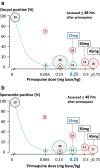Assessment of therapeutic responses to gametocytocidal drugs in Plasmodium falciparum malaria
- PMID: 25486998
- PMCID: PMC4295364
- DOI: 10.1186/1475-2875-13-483
Assessment of therapeutic responses to gametocytocidal drugs in Plasmodium falciparum malaria
Abstract
Indirect clinical measures assessing anti-malarial drug transmission-blocking activity in falciparum malaria include measurement of the duration of gametocytaemia, the rate of gametocyte clearance or the area under the gametocytaemia-time curve (AUC). These may provide useful comparative information, but they underestimate dose-response relationships for transmission-blocking activity. Following 8-aminoquinoline administration P. falciparum gametocytes are sterilized within hours, whereas clearance from blood takes days. Gametocytaemia AUC and clearance times are determined predominantly by the more numerous female gametocytes, which are generally less drug sensitive than the minority male gametocytes, whereas transmission-blocking activity and thus infectivity is determined by the more sensitive male forms. In choosing doses of transmission-blocking drugs there is no substitute yet for mosquito-feeding studies.
Figures










References
-
- WHO . Guidelines for the Treatment of Malaria. 2. Geneva: World Health Organization; 2010. - PubMed
-
- Price R, Nosten F, Simpson JA, Luxemburger C, Phaipun L, ter Kuile F, van Vugt M, Chongsuphajaisiddhi T, White NJ. Risk factors for gametocyte carriage in uncomplicated falciparum malaria. Am J Trop Med Hyg. 1999;60:1019–1023. - PubMed
-
- Drakeley CJ, Jawara M, Targett GA, Walraven G, Obisike U, Coleman R, Pinder M, Sutherland CJ. Addition of artesunate to chloroquine for treatment of Plasmodium falciparum malaria in Gambian children causes a significant but short-lived reduction in infectiousness for mosquitoes. Trop Med Int Health. 2004;9:53–61. doi: 10.1046/j.1365-3156.2003.01169.x. - DOI - PubMed
Publication types
MeSH terms
Substances
Grants and funding
LinkOut - more resources
Full Text Sources
Other Literature Sources

